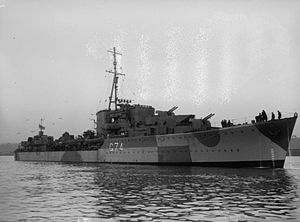HMS Legion (G74)

HMS Legion at anchor
|
|
| History | |
|---|---|
|
|
|
| Name: | HMS Legion |
| Ordered: | 31 March 1938 |
| Builder: | Hawthorn Leslie and Company, Newcastle upon Tyne |
| Laid down: | 1 November 1938 |
| Launched: | 26 December 1939 |
| Commissioned: | 19 December 1940 |
| Identification: | pennant number: G74 |
| Fate: | Sunk on 26 March 1942 in air attack |
| Badge: | On a Field Blue, an eagle displayed upon a perch Gold. |
| General characteristics | |
| Class and type: | L-class destroyer |
| Displacement: | 1,920 tons |
| Length: | 362.5 ft (110.5 m) |
| Beam: | 36.7 ft (11.2 m) |
| Draught: | 10 ft (3.0 m) |
| Propulsion: |
|
| Speed: | 36 kt (66.7 km/h) |
| Range: | 5,500 nmi (10,200 km) at 15 knots (28 km/h) |
| Complement: | 221 |
| Armament: |
|
HMS Legion was an L-class destroyer of the Royal Navy. She entered service during the Second World War, and had a short but eventful career, serving in Home waters and the Mediterranean. She was sunk in an air attack on Malta in 1942. The ship had been adopted by the British civil community of the Municipal Borough of Cheltenham, Gloucestershire in November 1941.
Legion was ordered on 31 March 1938 from the yards of Hawthorn Leslie and Company, Newcastle upon Tyne under the 1937 Naval Estimates. She was laid down on 1 November 1938 and launched just over a year later on 26 November 1939. During 1940 her main armament along with three others of the L class was changed. Twin 4 inch HA mountings were fitted and these four ships were re-classified as anti-aircraft destroyers. She was commissioned on 19 December 1940 at a total cost of £445,684, which excluded items such as weapons and communications equipment supplied by the Admiralty. During trials, a number of defects were revealed, resulting in the ship being under repair at Greenock in Scotland until January 1941.
Her commanding officer was, from commissioning until she was sunk in 1942, Captain Richard (Dick) Jessel.
On completion of repairs, Legion was assigned to the Western Approaches Command at Greenock as part of the 11th Escort Group. She was deployed on convoy defence duties, and also successfully trialled a modified Radar Type 286M using a rotating instead of fixed aerial array. In February she escorted military convoys through the North Western Approaches. She set sail in support of Operation Claymore, a commando raid on the Lofoten Islands, on 1 March. Following the successful completion of these duties, she joined the 14th Escort Group. On 13 April she rescued survivors from the armed merchant cruiser Rajputana which had been torpedoed in the North Western Approaches by the German submarine U-108. Legion rescued 177 men, although another 40 went down with Rajputana. The rest of April was spent escorting convoys.
...
Wikipedia
